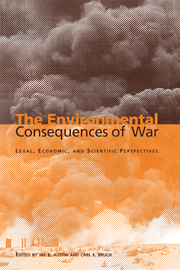Book contents
- Frontmatter
- Contents
- List of illustrations
- List of tables
- List of contributors
- Acknowledgements
- Foreword by Klaus Toepfer
- Introduction
- Part I General principles
- Part II The legal framework
- Part III Assessing the impacts – scientific methods and issues
- Part IV Valuing the impacts – economic methods and issues
- Part V Prospects for the future
- Introduction
- 22 Protecting specially important areas during international armed conflict: a critique of the IUCN Draft Convention on the Prohibition of Hostile Military Activities in Protected Areas
- 23 The Chemical Weapons Convention: a verification and enforcement model for determining legal responsibility for environmental harm caused by war
- 24 International legal mechanisms for determining liability for environmental damage under international humanitarian law
- 25 Waging war against the world: the need to move from war crimes to environmental crimes
- Epilogue
- Index
22 - Protecting specially important areas during international armed conflict: a critique of the IUCN Draft Convention on the Prohibition of Hostile Military Activities in Protected Areas
Published online by Cambridge University Press: 04 August 2010
- Frontmatter
- Contents
- List of illustrations
- List of tables
- List of contributors
- Acknowledgements
- Foreword by Klaus Toepfer
- Introduction
- Part I General principles
- Part II The legal framework
- Part III Assessing the impacts – scientific methods and issues
- Part IV Valuing the impacts – economic methods and issues
- Part V Prospects for the future
- Introduction
- 22 Protecting specially important areas during international armed conflict: a critique of the IUCN Draft Convention on the Prohibition of Hostile Military Activities in Protected Areas
- 23 The Chemical Weapons Convention: a verification and enforcement model for determining legal responsibility for environmental harm caused by war
- 24 International legal mechanisms for determining liability for environmental damage under international humanitarian law
- 25 Waging war against the world: the need to move from war crimes to environmental crimes
- Epilogue
- Index
Summary
Introduction
The creation of protected natural areas has long been an important conservation tool. Protected areas serve to preserve ecosystems, landscapes, and biological processes. Virtually every country in the world has domestic legislation creating protected areas, and several international environmental treaties require their creation. It is axiomatic that armed conflict can potentially harm these areas, especially since perpetuity and integrity are necessary attributes for achieving the overall conservation objectives. As leading authority Arthur Westing puts it:
Damage to protected natural areas in times of war can take the form of site disruption (through the expenditure of high-explosives, including the emplacement of mines, the expenditure of chemical weapons, the use of tracked and other vehicles, the setting of wildfires, the releasing of impounded waters, the construction of fortifications, the establishment of bivouacs, etc.), or it can be directed at specific components of the flora or fauna (through the cutting of trees, the hunting of wildlife, fishing, etc.). Damage to the infrastructure of a protected natural area can also occur, including the death and injury of personnel.
In light of what is at stake, it is useful to inquire into what protection the law affords to these areas during armed conflict and to explore possibilities for strengthening this protection. International law provides protection to certain areas during armed conflict. Examples include the 1972 Convention for the Protection of the World Cultural and Natural Heritage (World Heritage Convention) and the 1954 Hague Convention for the Protection of Cultural Property in the Event of Armed Conflict, both of which are administered by UNESCO. However, the effectiveness of these instruments is open to question.
- Type
- Chapter
- Information
- The Environmental Consequences of WarLegal, Economic, and Scientific Perspectives, pp. 567 - 578Publisher: Cambridge University PressPrint publication year: 2000
- 4
- Cited by



